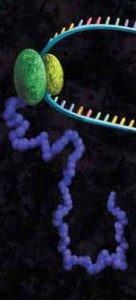In vitro translation of proteins through cell-free expression systems using rabbit reticulocytes, E. coli S30, or wheat germ extracts can be invaluable in studying protein function. If you only need a small amount (100s of nanograms), it’s also faster and easier than synthesizing vast quantities in bacterial or mammalian cells (~ 90 minutes for cell-free vs. long growth times and extraction steps after an initial optimization for protein synthesized in larger scale). There are many systems out there, and knowing which to use can sometimes be difficult. Many kits include components that combine transcription and translation in one-step, eliminating the need to provide your own RNA. But when you want to make your own RNA templates to add to lysates, then there are additional concerns.
Many people don’t want to work with RNA since the common lab lore suggests it’s a finicky molecule, and for good reason. Extracting it requires the utmost care in technique and elimination of nucleases. Failing to do so results in degradation of the molecule, and so with it your experiments (see our recent blog by Terri Sundquist on tips for isolating RNA with ease). Preparing RNA for cell-free expression is subject to the same concerns as extracted RNA, but with the proper care is not that much more of a challenge than using a DNA template.
The first step for using cell-free expression systems with RNA templates is to make the RNA. Here are some tips that will ensure success.
Continue reading “Lost in Translation? Tips for Preparing RNA for in vitro Translation Experiments”
